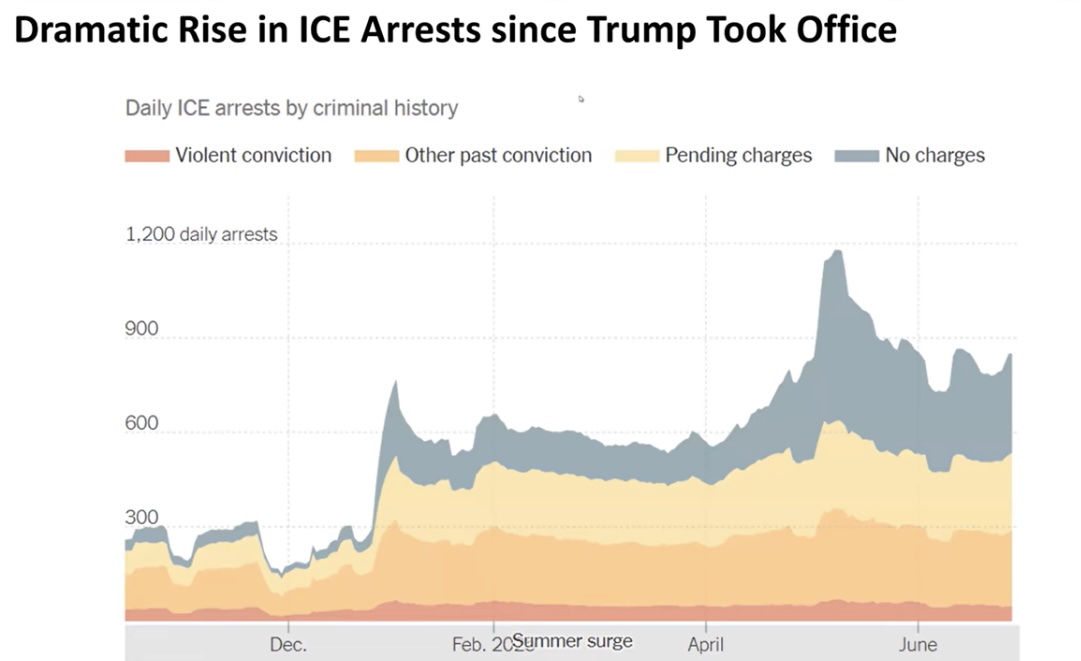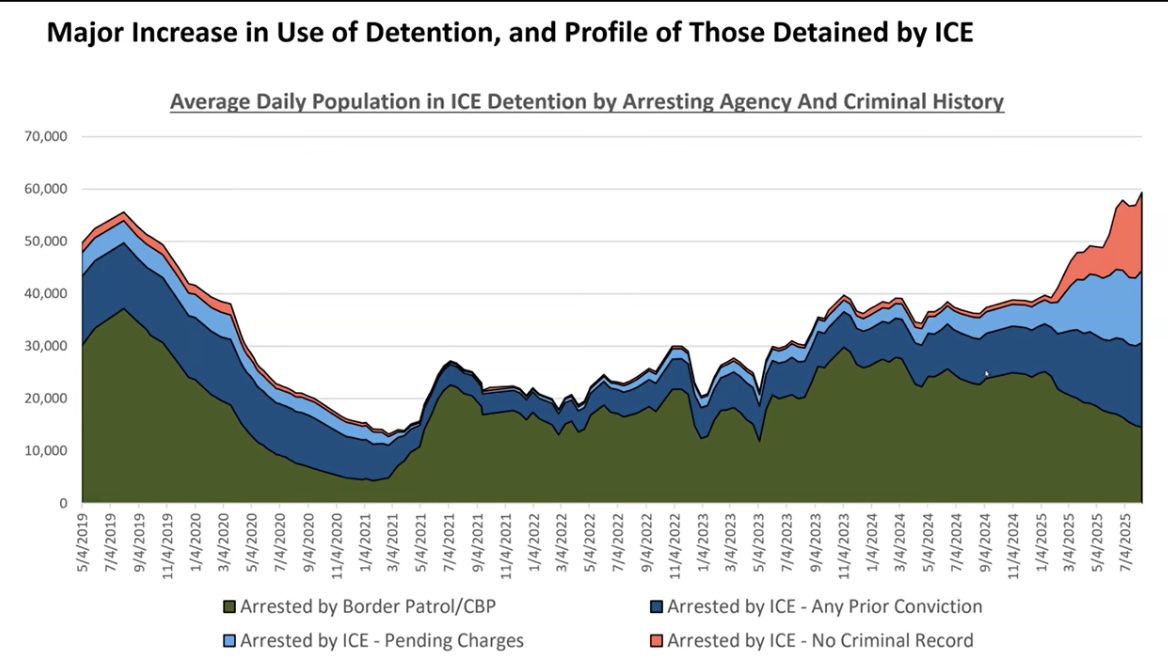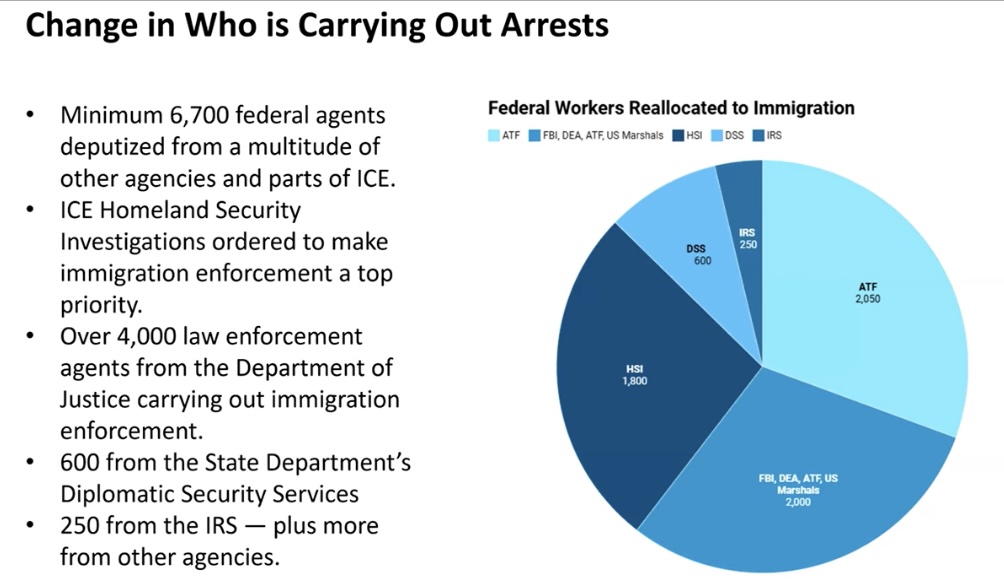If you’ve had a hard time keeping track of the policy developments and accompanying judicial stays related to immigration, you are not alone. This blog series is meant to provide an overview of the anti-immigrant policies enacted by the current administration, highlight data collected so far by respected organizations, provide a realistic sense of how this administration is likely to continue on immigration, and lift up areas of resistance and activism.
We pose a similar outline to the American Immigration Council’s recent report and attempt to answer the following questions in a series of 3 blog posts:
Part 1: Who are we detaining and deporting?
Part 2: Who is allowed into the United States?
Part 3: What is this doing to our communities? and How can we support one another?
Who are we detaining and deporting?
This administration campaigned on the narrative that they would deport the ‘worst of the worst’ immigrants in our country - meaning those with criminal records. In practice, they have shifted to detaining and deporting anyone who is undocumented, including law-abiding, tax-paying individuals who have built a life in the United States. Under previous administrations, this group of migrants were not at risk of deportation.
The definition of someone who is here unlawfully is complex and includes a diverse pool of people, not only those who crossed at the Southern Border. It encompasses all people residing in the U.S. who do not have legal status, including:
- Individuals who entered the United States lawfully (potentially through a work or student visa) and overstayed their visa;
- DACA recipients: DACA refers to Deferred Action for Childhood Arrivals, a temporary status that protects DACA recipients (people who arrived here as children) from deportation; DACA is currently in legal limbo;
- Individuals who entered the United States lawfully (through Temporary Protected Status, Humanitarian Parole, or other humanitarian/emergency parole programs) and have since had protected status revoked; these protections are also in legal limbo;
- Individuals who are in the process of pursuing legal status (via U.S. Citizen Spouse Petition, seeking asylum, etc.); and
- Individuals who entered the United States unlawfully without presenting themselves for inspection at an official checkpoint.
These are people who live and work within our communities, pay taxes, contribute to the local economy, attend local churches and mosques. They are our neighbors; their children go to schools in our communities. Many of them arrived legally and then the administration subsequently revoked the status they arrived under (see point 3 above). The legal pathways available to migrants and their families are deeply restrictive: “legal immigration is less like waiting in line and more like winning the lottery” (source: Cato Institute).
Steady Increase in Total Arrests
Nine months into the new administration, we have seen a steady increase in the total number of arrests. The Guardian U.S., uses data published every two weeks by Immigration and Customs Enforcement (ICE), to track the number of people the administration has arrested, detained, and deported. This is a good website to bookmark, since they update it weekly.
Since January 20, 2025 to September 22, 2025, there have been 228,090 total arrests (with 17,870 arrests in the period from September 9-22, 2025). The Guardian U.S. began archiving each release of detention data since January 2025, and received older releases from the Vera Institute. While we don’t have the data for the same time period last year, this chart from the guardian shows the steady increase in total number of arrests from the previous administration to this administration, with the highest spike June 3-6, 2025.
Increase in the Types of People Arrested/Detained
Data released through the Deportation Data Project confirms that there has been a steady increase in ICE arrests from February through April of 2025. In the chart below, you can see a noticeable spike in late May, when the White House demanded an increase in the number of arrests to hit 3,000 per day. This marks the shift in the types of people ICE began arresting, including arresting individuals without any criminal record, and those going to their court dates and ICE check-ins (those complying with ICE and going through the immigration court system).

The chart below shows that arrests at the border have gone down, largely because the administration shut down the option to seek asylum at the border (more on that below). They have repositioned Customs and Border Patrol (CBP) agents, who patrol the southern border and U.S. ports of entry, to the interior of the United States to carry out arrests.
The chart below also highlights the type of people ICE is arresting and detaining. The red data represents individuals who have no criminal record; we see this area of the graph continues to grow. As of August 2025, for the first time in U.S. history, there are more people in ICE detention who have no criminal record than those who do (source: American Immigration Council).

Immigration courts in the United States do not offer the same type of legal rights most Americans are familiar with. This is because an immigration offense in the United States is a civil offense, not a criminal offense. With a civil offense, and thus within our immigration court system, people do not have a right to a court-appointed lawyer; they must find and pay for their own lawyers. There is also no exception for children, who are also responsible for finding and paying for an attorney. Immigration advocates have long opposed this.
To make things worse, the current administration implemented the following policy changes (source: American Immigration Council):
- March 7, 2025: the administration reopened and reinstated family detention;
- May 15, 2025: the Board of Immigration Appeals ruled that any migrant arrested at the Southern Border was now placed in mandatory detention (regardless if they were granted humanitarian/conditional parole);
- September 6, 2025: Board of Immigration Appeals ruled that any migrant who entered the country without inspection, was ineligible for release on bond, overturning decades of practice.
These policy changes tell us that the administration is interested in keeping as many people in detention as possible. We wrote previously about the booming “detention-industrial complex” where companies associated with the current administration profit from these policies.
Shift in Who is Carrying out Arrests
Since this administration took office, at least 6,700 federal agents have been deputized from other federal agencies to carry out ICE arrests (source: American Immigration Council). This includes enforcement agents from the Department of Justice, the U.S. Department of State, and the Internal Revenue Service. These people now carrying out immigration-related arrests were not initially hired to take on this work and arguably are not qualified or trained in immigration law.
The chart below is not inclusive of Customs and Border Patrol (CBP) officers who have also been redirected from the border to interior enforcements, so the full number is likely much higher.

Increase in Movement of Detainees throughout U.S. and Around the Globe
The Guardian U.S. recently reported on how the administration's deportation program shuttles migrants around in a “lawless limbo” that is dehumanizing and continues to erode the few rights migrants are afforded when going through the U.S. immigration court system. Migrants have historically been shuttled between U.S. detention centers when detentions reach capacity, but there has been an increase in this type of movement under this administration.
The current system makes it increasingly difficult for attorneys, legal aid groups and family members to keep track of where their loved ones are held. According to government protocols established in 2012, ICE is supposed to minimize long-distance transfers and avoid moving detainees away from family and attorneys. The American Immigration Council and others have filed a lawsuit to determine if ICE has changed these transfer rules without notification. According to the National Immigration Project, “It really is very strange, you get someone who’s picked up, they go to a hold cell, they stay there for seven days – which is completely outrageous. They then get moved to Florida. From there, they get taken to Arizona, then they end up in Texas. It’s like this wild goose chase, trying to follow where the person is and what the reasons are even for moving them.”
Immigration officials are scrambling to find space in the detention system to hold detainees. The human stories of what our migrant brothers and sisters are going through are truly harrowing. The Guardian U.S. details the case of LW, a 37-year-old mother who came to the US with her 10-year-old son in April seeking asylum.
Data on Deportation
According to the Guardian U.S., which reviews and collates weekly figures from Immigration and Customs Enforcement (ICE) and Customs and Border Protection (CBP) starting from January 20, 2025 (Trump’s inauguration) the number of total deportations has now reached 234,210 Total Deportations (with 17,790 deportations in the period from September 9-22, 2025).
Deportation Flights
Human Rights First and the ICE Flight Monitor August 2025 Report confirms that there has been a steady increase in the number of deportation flights under this administration. Highlights from this report include the following:
- From January 20 to August 31, 2025, the administration carried out at least 7,454 total U.S. immigration enforcement flights. This number includes removal flights, removal-related flights, and domestic transfer ("shuffle") flights. The report defines “shuffle flights” as frequent domestic transfers to disorient individuals and make it significantly harder for them to access legal counsel and maintain contact with family (see above section on transfers).
- This is the highest number of enforcement flights for this period since tracking began in 2020. It is a 34% increase over the same period in 2024.
- The administration is conducting removal flights to new destinations, including Greece, Pakistan, Argentina, Azerbaijan, Chile, Kazakhstan.
- There has been an increase in multi-country removal flights, where 1 single flight removes individuals to multiple countries in a region - which can leave individuals shackled for more than 30 hours.
- The administration pursued agreements with a wide range of countries to facilitate third-country transfers (which sends individuals to nations of which they are not citizens and have no ties), including a newly established U.S.-Rwanda agreement. In August 2025, ICE Flight Monitor tracked the first flight to Rwanda.
- At minimum, 81 flights have been tracked to the offshore detention facilities at the U.S. Naval Station Guantanamo Bay (NSGB). There are two detention facilities at NSGB, which together, are reported to have capacity for about 200 detained individuals. 50 individuals have been held there at any given time over the past two months. The financial cost of this operation is staggering: detention at NSGB is estimated at $100,000 per person, per day (source: Reuters).
- The administration began using military planes to conduct ICE removals, which is more expensive than standard ICE Air Charter operations. There is also a lack of transparency about the human rights conditions on these military flights.
- At least 67 shuffle flights were conducted on U.S. Coast Guard aircraft, a practice that DHS quietly started in small-scale domestic transfers between cities with detention centers.
- On August 31, 2025, DHS attempted to deport 76 Guatemalan unaccompanied children on two flights, one from El Paso and another from Harlingen, Texas. However, a federal district judge blocked the planes from taking off after lawyers argued the children were denied due process and at risk of persecution if removed to Guatemala.
- Since February 2025, the United States has conducted 48 removal flights to Venezuela, returning 8,590 individuals, including families with children.
- The Mexican government carries out removal flights (referred to as "repatriation" flights by the Mexican government, which include both forced removals and voluntary returns) to various countries in Latin America, currently operated by the airline VivaAerobus. While the Mexican government has not conducted repatriation flights to Central America since May 2025, it continues to repatriate Central Americans by land.
All the data presented here exposes a harsh reality. We are witnessing what looks like a state-sponsored human trafficking scheme that violates US and international laws.
Part 2: Who Is Allowed Into The United States?
Part 3: What is this doing to our communities? and How can we support one another?



Comments
Bernadette Jones (not verified)
Besides being absolutely unAmerican, inhumane and immoral, these deportations are costing our country millions. Many of the people who have been deported were working, paying taxes and contributing to our country. Now with the costs of detention facilities, flights, personnel etc our government is spending tens of millions or more. I am sure the American people would prefer to see this money spent on health care, food for the hungry and education. This Administration's total lack of caring for the human person is outrageous. It extends to taking food and medicine from the poor around the world to cutting vital services to American citizens. We are in a very scary world.
Kim
Thanks for your comment Bernadette! We agree with you about the cost. With all the talk of DOGE, the government is more wasteful than ever, and at the cost of human rights and basic human decency.